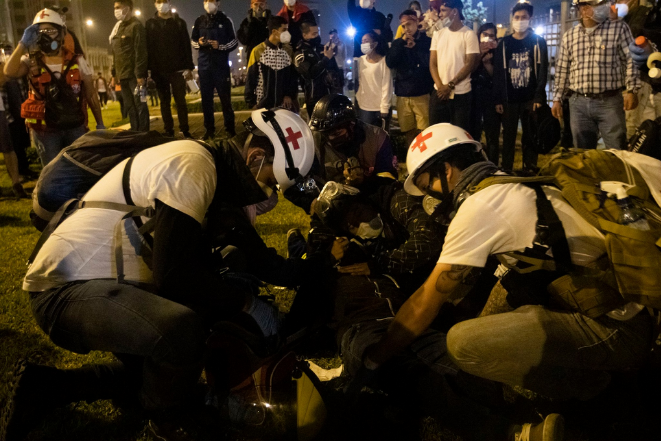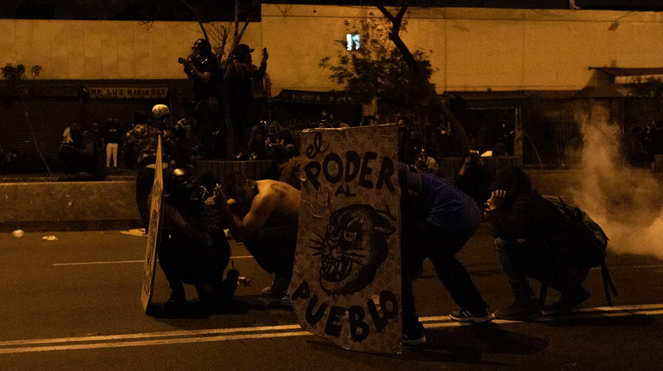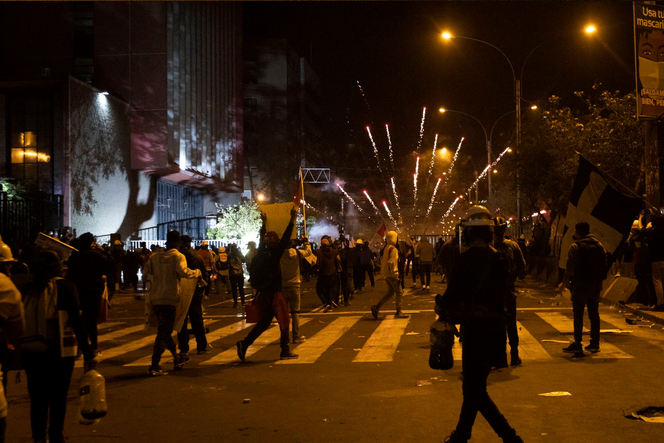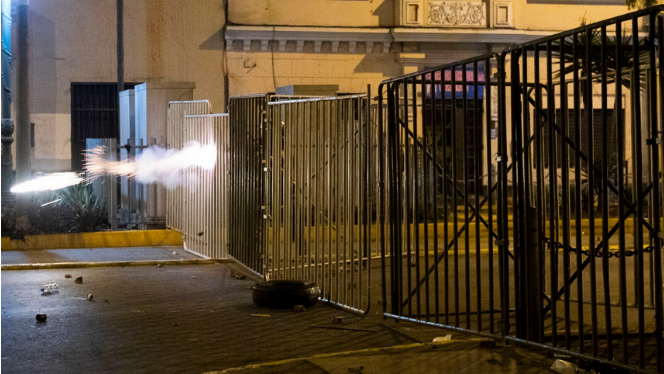Photos by Juan Zapata/Wayka.pe
After the Peruvian congress installed Manuel Merino as president on November 10, thousands of people took to the streets across the country.
Faced with a political class that doesn’t represent the people and a pandemic that hit the South American country hard (despite harsh restrictions imposed by President Martín Vizcarra’s administration), indignation, anger, and uncertainty pushed thousands over the edge. They filled the plazas and avenues for days after what many have called a coup.
In response, the new government was quick in repressing the demonstrators with excessive violence by Peru’s National Police.
Bullets in Response to Protests

On November 14 during a national march against Manuel Merino’s power grab and the majority of Congress, brutal police repression left two dead: Jack Bryan Pintado Sánchez, 22, and Jordan Inti Sotelo Camargo, 24. Both suffered multiple gunshot wounds at the hands of the police.
The Center of Emergency Health Operations, part of Peru’s Ministry of Health, reports that “a total of 107 citizens were seen for injuries suffered during the mobilization. Of these, 73 have been discharged and 34 remain hospitalized.”
The National Coordinator of Human Rights (CNDH) reported that there are missing persons and launched a campaign for residents to report if their family members or friends hadn’t returned from the demonstrations. On a live-updated list, at the time of this article’s publication the CNDH reported four people still missing from a list of more than 60. The organization stated that “we have knowledge of sexual violence against two young women detained in a printshop the night of November 14. The women reported being sexually assaulted and this must be investigated exhaustively. We know that the police have made illegal and arbitrary arrests.”
Human rights organizations formalized a criminal accusation against Manuel Merino as well as the transitional prime minister Ántero Flores-Aráoz, former interim minister Gastón Rodríguez, General Jorge Luis Cayas Medina, the Lima chief of police, Director General of the National Police Orlando Velasco Mujica, and all those responsible for the crimes of homicide, abuse of authority, and grievous bodily harm against the protesters. The organizations filed the charges with Zoraida Ávalos, Peru’s Attorney General.
The document also mentions that prior to swearing in nine new ministers on November 11, Manuel Merino called former Minister of the Interior Cesar Gentile to request that he intensify repression and stamp out the protests.
Among those affected, the document mentions Jack Bryan Pintado Sánchez, Jordan Inti Sotelo Camargo, both now deceased; Luis Alejandro Aguilar Rodríguez, 26; Percy Pérez Shaquiama, 26; Rubén Guevara, 27; Ernesto Benavides Raez; Rene Jenrry Ccaqui Crisostomo; José Manuel Romero Rivas; José Miguel Hidalgo Rodríguez; Roberto Muñoz Torres; Alonso Vhro Ucea; Alfonso Balbuena Bellatín, and others who have not yet been identified.
Coup

In an interview with Avispa Midia, reporter Roxana Loarte from Wayka.pe said, “This coup was brought about by several party factions with not just political but economic interests in laws in the making and links with state institutions like the Constitutional Court. This has been a contest between two state powers, the executive and the legislative; it’s a struggle between right-wing groups. Martín Vizcarra, the president who was removed from office, is being investigated; he is also under investigation by the Attorney General’s office for corruption in positions he held previously in regional government.”
“There are over 60 congresspeople in Parliament, 68 to be exact, under investigation by the Attorney General’s office, not just for corruption but other acts as well. The people are indignant at this landscape of not only corruption but also uncertainty, an institutional crisis and a weakened democracy, and on top of it all, the repercussions of the pandemic,” says Loarte.
On Sunday November 15, Merino resigned as President of the Republic. All members of the Congress’s General Committee stepped down as well. Now, a congressional majority must elect a new Committee from the lists presented by the parties. The Board of Spokespersons convoked a plenary session for 4 p.m. that same day.
After several hours in session, with thousands of people in the streets, the representatives voted on one of the lists proposed to form the new General Committee, headed by Representative Rocío Silva Santisteban, a feminist congresswoman who did not vote for Vizcarra’s removal. However, it did not achieve the 60 votes necessary to be approved, which mean parliamentary groups resumed negotiations in search of a new path.
The head of this new General Committee would automatically assume the functions of President of the Republic until July 2021, by which date power must be transferred to the person elected by the Peruvian people in the presidential elections planned for April.
Meanwhile, Peru is in the middle of one its worst political and social crises, during a pandemic, with thousands of deaths and an economic crisis. Congress is made up of primarily right-wing politicians who refuse to let go of their privileges, and those most affected in this situation are those who were already the most vulnerable.
With a health system at the point of collapse, Peruvians face a bleak outlook even though the victory of having expelled the interim government has filled the streets with hope. The 2021 elections will no doubt reflect these lessons in the face of an indolent and out-of-touch political class.






